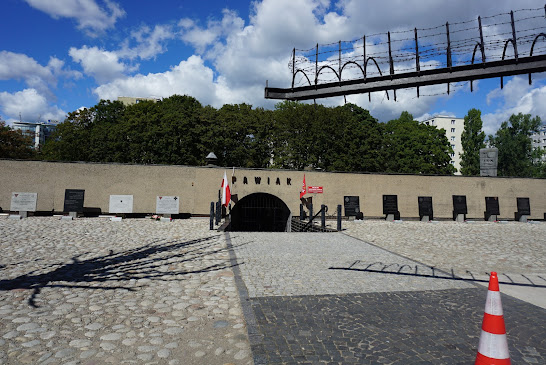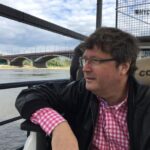World War II in Warsaw
#Warsaw tour guide #Warsaw city guide # guided tour in warsaw #Warszawa tour guide #Warszawa city guide #guided tour in Warszawa
The beginning of World War 2
Poland was attacked by Nazi Germany on 1 September 1939, and 9 days later artillery bombardments of Warsaw began. Later, the city was carpet bombed and on 28 September the surrender was signed. The attack caused the first war damage to the city and of around 12,000 Polish casualties, over 80% were civilians.
The city was destryed after uprisings in 1943 and 1944
Later, the entire Jewish ghetto was completely destroyed after the Jewish uprising in 1943, and after the Warsaw Uprising in 1944, the Germans systematically attempted to destroy the city – but only partially succeeded.
Also read the article Jewish Warsaw
The story of the extermination of the Jewish part of the city is of course also part of World War II, but in order not to be too repetitive, these parts are placed under “Jewish Warsaw” (click here).
The war in Polish consciousness
In fact, you can also include the many rebuilt areas as part of a tour around World War 2. The rebuilding of the Old Town and the Jewish ghetto area, among others, was of course a direct consequence of the war’s devastation.
The awareness of World War II goes far beyond what is told by monuments and museums. Poland was probably the country that paid the highest price for the war, and the destruction and humiliation is everywhere in Polish cinema, literature and school curricula, along with the stories of the Polish resistance. In other words, World War II is far more present in Polish consciousness than in many other European countries.
The military cemetery
The Military Cemetery (Cmentarz Wojskowy na Powązkach) – Address ul. Powązkowska 43/45. 3-400 metres from Cmentarz Powązkowski.
The military cemetery, which is possibly even more impressive than the civilian cemetery, which is twice the size. Many of the participants in the Warsaw Uprising are buried here.
Museum of the Warsaw Uprising
address: Grzybowska 79 (Metro Rondo Daszyńskiego).
We start with a pub located next to the museum, where there is a bridge to the exhibition area. The summer room, it’s called. There are hanging chairs and trees through the floor and ceiling. It’s a lovely room. They’ve also created a guest house for plants, where they will take care of your greenery while you’re on holiday.

Touch and feel – a museum constructed with the aim of patriotic education
The museum itself is an experiential museum, which to a certain extent is probably constructed with patriotic education of school classes in mind. It is not the individual exhibits that are important, but the overall experience, the sounds, the light. You have to feel the rebellion, and the museum has to tell the story that has been decided is the right one.
The Warsaw Uprising divides the Polish people
The Warsaw Uprising divides the population into two groups – those who see it as collective suicide and those who see it as an expression of national heroism. However, after many years of official worship of the uprising, the opponents of the uprising are now in a clear minority.

The Russians were close, but Stalin wanted the uprising to fail
The uprising started at a time when the Soviet troops were on the other side of the river and probably could have easily gone in and liberated Warsaw. The plan was for the rebels to say thank you for the help, but we’ve actually just liberated Warsaw (and Poland) ourselves, so we don’t need the Red Army to organise the country for us. But you are welcome to continue through Polish territory towards Germany.
Of course, Stalin had smelled this plan, so he didn’t dream of sending troops into the city until the rebellion was crushed by German troops.

The freedom fighters believed the Red Army would come to rescue, the leaders knew, it wouldn’t
The freedom fighters had been led to believe that the Red Army would step in to help, making it easy to recruit citizens to the rebellion at a time when it was clear that Germany was losing the war. However, the leadership of the rebellion was well aware that Stalin would not come to the rescue. The whole affair is open to interpretation and many different accusations are levelled at different participants.

As a drawing board project, the museum has existed for many years, in 2002 the then mayor of Warsaw (and later Polish president) pushed for an urgent opening of the museum for the 60th anniversary of the uprising, and the museum was opened in 2004 in the old power station of the tram network.
Commemorative plaques and monuments
Commemorative plaques. Address: Everywhere
Germans would round up people and kill them or take tehm to germany to work
The Germans had a tedious habit of rounding people up, something called Lapanka. Sometimes it was to round up random people to work in Germany, other times it was in retaliation for an attack on the Germans. In the latter case, you would gather as many people as you saw fit, and then the Germans would open fire and kill this group of random people. It could be 12-20 people, sometimes half a hundred.
The places where the Germans killed random people and members of the resistance are marked with a memorial plaque or stone, and especially when walking around the city centre, you’ll come across many of them.

Pawiak Prison Museum
Address Dzielna 24/26. Metro Ratusz Arsenał. Wednesday to Saturday 10-17.
A large and now demolished prison from 1835 (Russian times); The area around the old prison has been converted into a museum dedicated to the housing of people from “Lapanka” and the resistance movement during World War 2.

See the cells and feel the atmosphere
You can see the old cells, feel the atmosphere and also get an impression of life as a prisoner during the German occupation 1939-1945, when it was normal for one or two killed German soldiers to result in 100 executed Poles.
Katyn Museum
Katyn Museum (Muzeum Katyńskie) Address: ul. Jana Jeziorańskiego 4. Open Wednesday to Sunday 10-16. Located as part of the Citadel.
All Poles know about Katyn, where 22,000 Polish officers were killed by Stalin’s soldiers
Katyn is an integral part of Polish historical consciousness. In 1940, at least 22,000 prisoners of war were killed by Soviet troops on the orders of the communist leadership. Those killed were predominantly non-commissioned officers and representatives of the Polish intelligentsia, and as such were considered class enemies of the new Poland that Stalin was planning after the end of the war. The Russians blamed the Germans for the mass execution, and it wasn’t until 1990 that the Soviet leadership officially recognised that the Soviet Union was responsible for the murders.
You feel the suffering but also see the light at the end of the tunnel
It is a time-symptomatic museum of suffering, which, through dark corridors and lights at the end of the tunnel, is intended to give an impression of the suffering the Russians inflicted on the Polish people.
Andrzej Wajda’s film from 2007 – Katyn provides a dramatic introduction to the massacre
However, the museum is a holistic experience and really an architectural gem where every effect is well thought out. The visit is a line in which you experience the path of the Polish victims and gain insight into what they endured; perhaps even more than that – knowing the history of the prisoners (which all Poles know thoroughly), you relive their suffering with them. Andrzej Wajda’s 2007 film, Katyn, provides a dramatic introduction to the 1940 massacre if you want to prepare for your visit.

The entrance to the museum through a symbolic dark forest, where you briefly emerge into the clearing before entering the museum. It goes on like this the whole time. The dark colours are omnipresent.


Monument to the Warsaw Uprising
On the square in front of the Supreme Court. Street intersection Długa/ Plac Krasińskich. Access from the New Town (Długa Street) or Metro Ratusz Arsenał (also Długa Street, but from the other side).
The story behind the monument: see above “The Museum of the Warsaw Uprising”. It is a huge monument in several sections, the main motif of which is the ascent from the sewage canals through which the participants of the uprising fled the Old Town.

The Little Freedom Fighter
The Little Freedom Fighter (Pomnik Małego Powstańca) – Corner between Podwale Street and Wąski Dunaj Street.
The Children of the Warsaw Uprising
A one and a half metre tall boy symbolising the children who participated in the Warsaw Uprising. In its original form by Jerzy Jarnuszkiewicz in 1946, it was sold in miniature copies until its official installation in 1983.
Some people don’t like the fact, that children actually fought
The statue has been controversial because it depicts children fighting with firearms in a dirty war. Some historians are keen to play down the role of the children, claiming that they were mainly involved in transporting illegal printed leaflets.

Tomb of the Unknown Soldier
Tomb of the Unknown Soldier (Grób Nieznanego Żołnierza) – Piłsudski Square, towards Saski Park. Part of the palace of the old Saxon kings, which was destroyed during World War 2.
It is guarded around the clock, and with a little luck, you will see the change of guards
The tomb of the first unknown soldier was erected in 1925, modelled on the Parisian model, and was rebuilt in 1946 after the destruction in 1945.
The tomb is guarded around the clock by two immobile soldiers, and once an hour there is a change of guard, with the replacement marching across the square. It is also the site of many of the ceremonial military parades in the capital.

Tracks from a German tank
– Dziekania Street
In the Old Town, if you walk towards the square behind the cathedral, you will pass a piece of tracks inserted into the wall. A reminder of a series of explosions in the Old Town in 1944, where German tanks were destroyed and it was later decided to preserve a reminder of the fighting in the church’s brickwork.

Monument to the Kosciuszko Division
The Kosciuszko Division was the name given to the a division of the Polish People’s Army that fought alongside Stalin’s Red Army during WW2 (the name refers to a Polish general who led the fight against the Russians in 1794).
When the Warsaw Uprising broke out in 1944, the Kosciuszko Division tried unsuccessfully to cross the river and aid the uprising against Hitler. Stalin’s soldiers remained on the other side of the river, because Stalin had no interest whatsoever in the success of the Warsaw Uprising against the German troops.

BIG monument from 1985
However, the Kosciuszko Division was recognised by the communist authorities and its efforts were rewarded in 1985 with a bizarrely large monument, popularly known as the ‘5 Beers’ because of the five spread fingers.
You can’t miss the monument if you walk or cycle across Warsaw’s new pedestrian bridge, located a few hundred metres from Metro Centrum Nauki Kopernik
Please send an email to m@hardenfelt.pl if you would like an English-speaking tour guide to show you the most important places in Warsaw.

